




Welcome to this third newsletter from the School of Computer Science and Engineering. This edition showcases the latest news, achievements and stories from both the school and our alumni. We share research highlights, including a PhD student receiving a CoSeC Impact Award for Advancing XRay Simulations, and the development of innovative Radar technology to understand honeybee movement. It is also the end of an era, since I’ll be stepping down as the Head of School after 11 years this June and handing over the reins to Professor William Heath who joins us from the University of Manchester, where he has been Chair of Feedback and Control for the last six years and was Head of Department of Electrical and Electronic Engineering from 2019 to 2022.
It has been a year of exciting research outputs, including technological breakthroughs which may be key to overcoming 5G network limitations, but I would also like to take this opportunity to remember colleagues who have passed this year, including Alwyn Owens and Professor Nigel John who will be sadly missed.
The school has run a fruitful outreach programme again this year, opening its doors last June for aspiring young engineers aged 5-13 and their parents / guardians as part of the IET Open House Week. The NFI (Nuclear Futures Institute) gave a tour of their brand-new laboratory facilities, and also had some hands-on demos, including Lego Mindstorms and outreach equipment on loan to the NFI from Magnox. The DSP (Digital Signal Processing) Centre had the participants build their own torches and learn about Morse code, and then sent an encrypted Morse code message down an optical fibre for others to decrypt. Finally, Technocamps had them battle it out as code breaking teams to solve a number of mind-bending clues to compete with other teams be the fastest to open a box, before their time ran out.
In December 2023 we hosted the IET Faraday Challenge for the second consecutive year where 6 teams of 6 (from year 8) from 5 local schools competed against each other for the glory of being crowned the Faraday Challenge Day Winners.
We are open to hearing from other partners about their experiences with organizing similar events and also welcome companies to join us in collaboration for the next year. If you are interested, please reach out to our School Liaison, Dr. Daniel Roberts at d.r.g.roberts@bangor.ac.uk
Are you currently working in the fields of Computing, Engineering or Product Design? We would be thrilled to hear about your experiences and explore potential collaborations. We offer numerous opportunities, including industrial presentations, guest speakers, and joint research initiatives. Additionally, we would be honoured to showcase your work in our next newsletter.
Best wishes,
Dr Iestyn Pierce, Head of School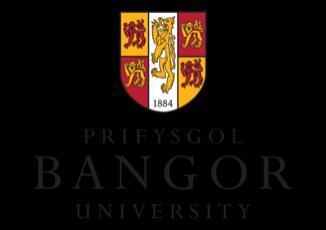

School of Computer Science and Engineering Bangor University, Dean Street, Bangor, Gwynedd, UK, LL57 1UT
https://www.bangor.ac.uk/computer-science-and-electronic-engineering/ https://twitter.com/bangorcsee?lang=en +44 (0)1248 351151 csee@bangor.ac.uk
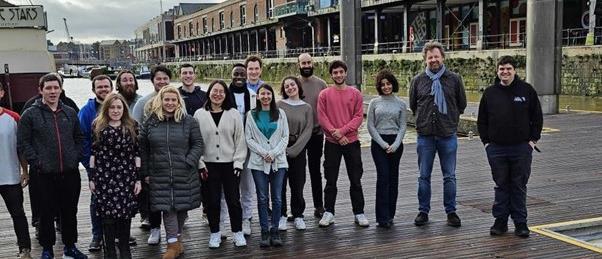
PhD students from Bangor, funded under the AIMLAC Doctoral Training Centre, recently went on a training week in Bristol.
The AIMLAC Doctoral Training Centre hosted an enriching training week from January 23rd to 25th in Bristol. It brought together doctoral students from Bangor, Aberystwyth, Cardiff, Swansea, and Bristol eager to delve into the world of quantum computing and enhance their technical skills. AIMLAC is funded by UKRI Research and Innovation.
The training week commenced with a deep dive into the basics of quantum computing, offering students a comprehensive understanding of this innovative field. The students are also engaged in a coding challenge, and the Bristol event provided them with the opportunity to catch up with their current coding solutions. This challenge not only tests their skills but also allowed them to apply theoretical concepts that they have been learning in their training. In addition to quantum computing, the AIMAC training week included training in Docker and SQL, equipping them with practical skills essential for modern research and development.
Participants were privileged to have a session by Professor Jonathan Roberts on Information Visualization where they delved into the art and science of representing complex data in visually comprehensible ways. And another session by Annabel Jenkins on “connecting with the audience and getting your message across live or online”. They received guidance on connecting with their audience and effectively conveying their messages in both live and online settings. This skill set is particularly crucial in the ever-evolving landscape of academic and professional presentations.
Mr Glory Ogbonda, a PhD student at Bangor University funded by AIMLAC, said “Overall, the AIMAC Doctoral Training Centre Week in Bristol proved to be a wonderful experience. It blended quantum computing insights, coding challenges, with technical skill development. In addition, I really enjoyed meeting with students who are studying different PhD topics and learning about their experiences.”

Bangor University’s valuable role in advancing new era nuclear research has been confirmed this week as the National Nuclear Laboratory (NNL) announced a £9.35million investment in two projects: an innovation centre and design of test facility.
The NNL will partner with industrial and academic partners, including Bangor University, to support the development of nuclear fuels capabilities in the UK through the creation of a Uranics Innovation Centre. Funding has been provided by the Department for Energy Security and Net Zero’s Nuclear Fuel Fund.
The Uranics Innovation Centre is an industrial and academic partnership to support the development of front-end fuels capabilities in the UK. This will be achieved through the supervision of a series of post-doctorate and master’s degree research projects with NNL’s partner universities including Bangor University, Lancaster University and the University of Manchester. Research projects will include Light Water Reactor fuel supply, HALEU supply chain, Advanced Modular Reactor fuel fabrication capabilities and enabling UK fuel production capabilities.
“It is exciting to see this level of support from Government, ensuring that the skills and the cutting-edge research is there to meet the ambitions that will enable the UK’s low carbon energy future. Nuclear fuel research will allow the UK to support our excellent industry partners and grow our capabilities for decades to come.
Bangor University, through programmes such as this, is cementing Wales’ position as a forward-looking, sustainable and innovative nation, and we want to continue to grow our influence in this exciting area and others that will bring prosperity to the region.
“We need to foster the engineers and scientists of the future to support growth in this key area, and here at Bangor University students can now learn nuclear science, materials engineering and mechanical engineering on the General Engineering Bachelor and Masters courses. Please do not hesitate to visit us here in North Wales.”
Simon Middleburgh, Professor in Nuclear Materials at Bangor University's Nuclear Future Institute (Right)
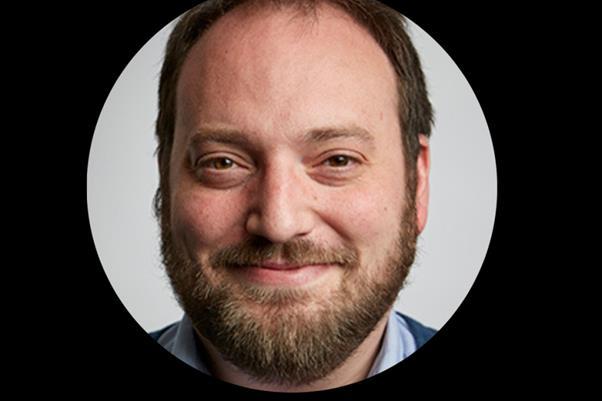
As part of the NNL’s announcement Dr Gareth Headdock, Chief Science and Technology Officer at the National Nuclear Laboratory, said:
“We are in the midst an exciting period of nuclear fuel development. Advanced fuels will enable the next generation of nuclear reactors to provide high grade heat to industry – a major contribution to our ability to meet net zero. As the UK’s national laboratory, it is vital that we develop skills and capability to ensure that, as a nation, we can develop and deliver the full fuel cycle.
“These two projects will not only deliver on the UK Government’s immediate requirements for fuel research and development; the insights we gain will provide further opportunities for future projects as the world looks to nuclear power to meet our global development goals for clean energy.”


The school of Computer Science and Engineering ran an end-of-year social for staff and students. The festive social was attended by over a hundred staff and students and was a memorable event.
In a wonderful display of holiday spirit, two enterprising undergraduate students (Senior Rep - Pranav Sabuji, and Ben Kendall), together with the schools' other course reps, organised a memorable Christmas party that brought together staff and students for an afternoon of laughter, fun and games.
The event was held at the school’s common room on December 6th, and was a resounding success. With people encouraged to wear Christmas jumpers (with the winner getting a £20 Amazon voucher), and attendees expressing delight at the festive atmosphere and engaging activities. The duo (Pranav and Ben) went above and beyond, to create an experience that would be remembered for years to come.
The first game was Bingo, with prizes of a £10 Amazon Voucher for One Line; £20 for two, and £30 for a full house.
Another highlight was the quiz. People split into teams and gave themselves unique names. The winning group team was “Team Ralph,” with runners up of Academics Anonymous (a group of academics), and Jingle Byte (degree apprentice and PhD students).


The quiz featured several rounds of different activities. One task was the "Academic Photo Mixup," a clever mashup of Christmas movie scenes and academic faces that left everyone in stitches as they tried to match the quirky combinations. Everyone got out of their seats to "find the lost soldiers" a bustling hunt for toy soldiers strategically hidden throughout the space. The general knowledge quiz added an element of friendly competition to the afternoon. With the "what's in the box" game, getting participants to bravely stick their hands into mystery boxes, of toys and food, guessing the contents with a mix of excitement and trepidation.
People enjoyed pizza, brownies, drink, coffee, and tea, with our international cohort also brining some Arabic coffee and sweets for all to enjoy. With staff and students laughing and joking together. Dr. Daniel Roberts, Coleg Cymraeg Cenedlaethol senior lecturer in Electronic Engineering, and the School’s Director of Student Engagement, expressed his enthusiasm for the event, stating,
“In my years here, this has been the best staff/student party the school has ever had. Pranav and Ben have truly outdone themselves, creating an atmosphere that embodies the spirit of the season and fosters a sense of community. The success of the Christmas party underscores the importance of fostering a sense of community here at Bangor, and their dedication and creativity, have not only brought joy to their peers but have set a high standard for future events at Bangor University.”
Dr Roberts, ended by saying:
As the semester draws to a close, and students prepare to leave for the festive vacation, we look forward to another year of learning and fun here in the school.”

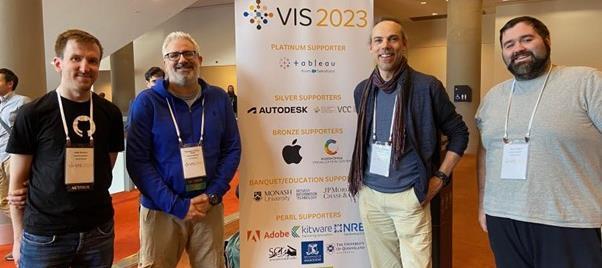
Academics from Bangor University participate in the largest Visualisation conference: the IEEE (Institute of Electrical and Electronics Engineers) VIS 2023. The conference brought together academics and researchers from around the world.
IEEE VIS is the largest annual conference on data visualisation. It is a conference that is organised by volunteers representing the IEEE (Institute of Electronics and Electrical Engineers). This year, it was held in the southern hemisphere for the very first time, in Melbourne Australia. It attracted attendees from around the world. The 2023 edition of VIS (the Visualization and Visual Analytics Conference) ran from October 21st to 28th October 2023.
Jonathan C. Roberts, Professor in Visualisation said “Melbourne felt like home; one day it rained, the next day was hot and sunny, and attendees and the locals were warm and welcoming. I had brilliant research conversations with many attendees. It was one of the best Visualisation conferences that I had attended.”
Four academics and researchers from the School of Computer Science and Engineering attended the conference. Aron Owen, a PhD student studying visualisation design; Dr Peter Butcher (lecturer in Human Computer Interaction), Dr Panagiotis Ritsos (Senior Lecturer in Visualisation) and Professor Jonathan Roberts (Professor in Visualisation).
Professor Roberts went on to say,“We were involved in many activities, we published three journal papers, four poster papers, co-chaired the short papers stream, helped run a workshop on Education and Visualisation, and were involved in the doctoral colloquium. It was a busy and exciting conference. We were all moved by the lovely remembrance presentation, at the start of the conference, by Prof Min Chen, of our colleague Professor Nigel John, who passed away, and was a previous professor at Bangor University”.

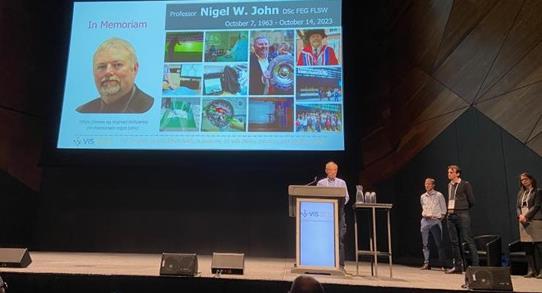
Right
Right bottom: Introduction and remembering Prof Nigel John. Credit: School of CSE
Panos and Pete presented two journal papers: “Wizualization: A "Hard Magic" Visualization System for Immersive and Ubiquitous Analytics” and “The Reality of the Situation: A Survey of Situated Analytics.” Jonathan presented his journal paper titled “Challenges and Opportunities in Data Visualization Education: A Call to Action” and was joint programme chair for the Short Papers programme, and the workshop on Education and Visualisation (EduVis).
Aron was privileged to be invited to participate in the doctoral colloquium.
In addition, the group presented four poster presentations and two workshop papers:
• Inspire and Create: Unveiling the Potential of VisDice in Visualization Design
• Less is more: Focused Design and Problem Framing in Visualisation – Developing the ColloCaid Collocation Editor
• RAMPVIS: Answering the Challenges of Building Visualization Capabilities for Large-scale Emergency Responses
• DUVis: A visual analytics tool for supporting trans-disciplinary projects
• A method for Critical and Creative Visualisation Design-Thinking
• Creating storytelling visualizations for the Covid-19 pandemic using Feature-Action Design Patterns
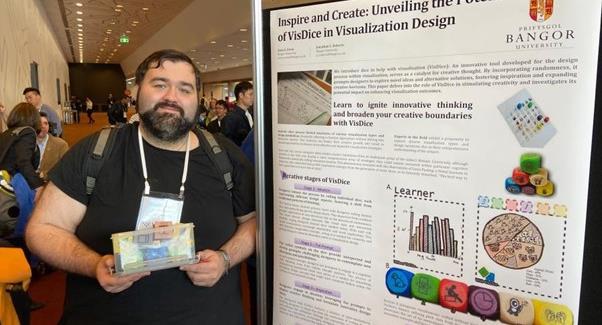
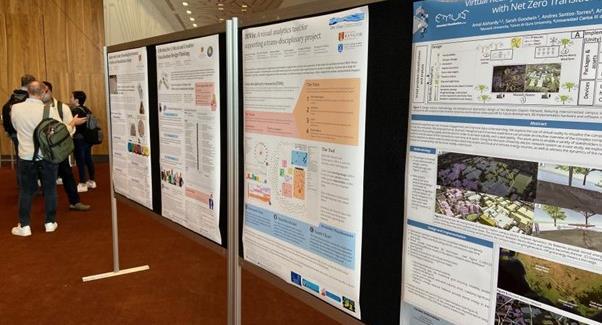
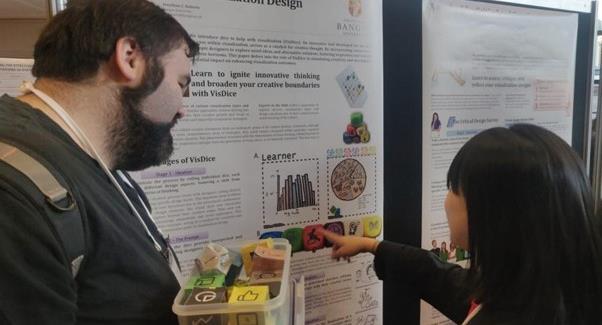
“The doctoral colloquium was great; I was able to present my research to international researchers. The poster presentation was my highlight. I had tens of people come up to me and ask me about my research. The interaction with people at the poster was brilliant.”
Aron Owen, PhD Student studying Design isualisation (Left)
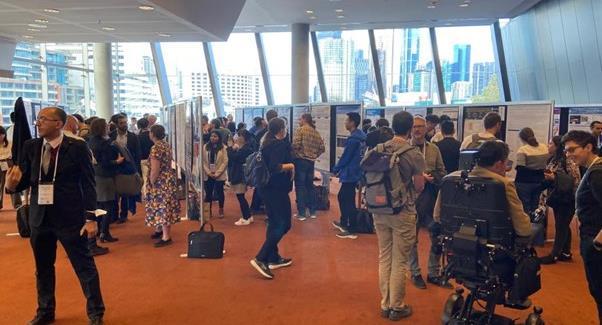
 Left and Above: Poster session Credit: School of CSE Below: Melbourne City
Left and Above: Poster session Credit: School of CSE Below: Melbourne City

Following its success last year, on the 29th of November 2023, the School of Computer Science and Engineering hosted the IET Faraday Challenge. The Faraday Challenge is an annual competition of STEM activity days with a real-world challenge for pupils aged 12-13 years. The theme partners for this year are the Rees Jeffreys Road Fund, and National Highways. The winning team from each event take home a voucher for themselves as well as gaining a place on the national league table. The top five teams at the end of the season will be treated to an all-expenses-paid trip to the final, as well as a chance of taking home £1,000 for their school to spend on STEM activities.
This year, 6 teams of 6 from Ysgol Dyffryn Ogwen, Ysgol Friars, Ysgol Tryfan, Ysgol Syr Hugh Owen and Ysgol Llangefni. Teams competed against each other for the glory of being crowned the Faraday Challenge Day Winners. At the event, teams were challenged to create a prototype for improved highway safety, either in rural communities, or on the motorways. They were required to present their prototypes, including an explanation of the design and functionality, discussion of the most difficult engineering problem encountered, an assessment of their team dynamics, and a demonstration of the prototype in action. At the end of the day, Ysgol Llangefni were crowned the winners with an excellent winning score. The event was a tremendous success and was well-received by both the participants and the hosts. The school will certainly be signing-up to host another IET Faraday Challenge Day in 2024.
Dr Daniel Roberts, senior lecturer in Electronic Engineering at the school, and the schools outreach officer, said “Hosting the Faraday Challenge again this year was a great privilege as we can welcome aspiring Engineers and Scientists to our department and inspire them to pursue a career in STEM. These events provided a valuable chance to highlight the possibilities in Engineering and Computer Science as educational and professional paths for the students. Our school is dedicated to organizing similar occasions to motivate the future generation of Engineers and Computer Scientists.”
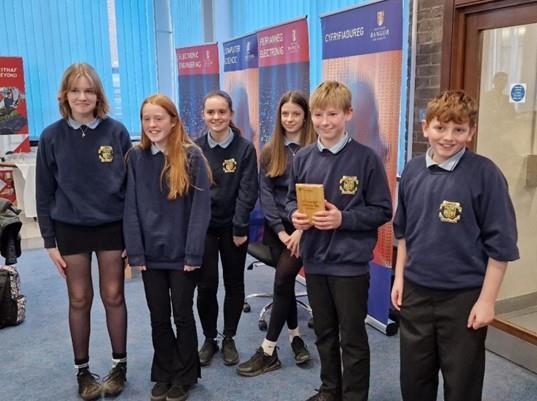
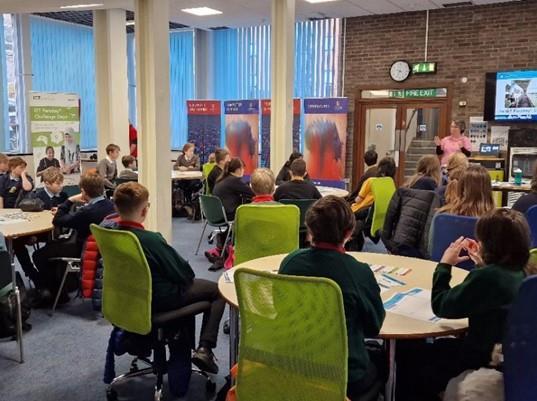
Top: Ordering components from the shop and preparing parts at the cutting station.
Credit: D.Roberts
Far Left:: Ysgol Llangefni, the winners on the day! Credit: D. Roberts
Left: Schools listening carefully to the brief for the day Credit: D.Roberts
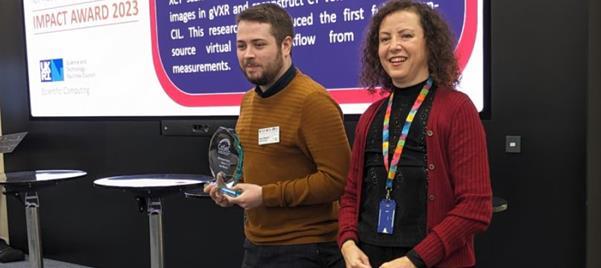
PhD student Iwan Mitchell wins the 2023 CoSeC Impact Award, for his work on simulation and visualisation of Xrays. The award was made at the First CIL User Meeting organised by CCPi and was presented by CoSeC Director Dr Barbara Montanari.
At the First Core Imaging Library (CIL) User Meeting organized by CCPi (The Collaborative Computational Project in Tomographic Imaging), Iwan Mitchell from Bangor University was awarded with the 2023 Computational Science Centre for Research Communities (CoSeC) Impact Award for his groundbreaking work in scientific computing.
CIL is an open-source Python framework for tomographic imaging with particular emphasis on reconstruction of challenging datasets. The award ceremony, led by CoSeC Director Dr. Barbara Montanari, was part of a day dedicated to sharing insights and advancements in computational imaging. Later, on the same day, Iwan had the opportunity to present his work “Creating Functional Digital Shadows of X-ray Systems” to the audience. In the talk he explained the complexities of X-ray Computed Tomography (XCT).
Iwan Mitchell is studying for his PhD at Bangor University and is funded by the Artificial Intelligence, Machine Learning and Advanced Computing (AIMLAC) UKRI (UK Research and Innovation) centre for doctoral research.
Mitchell's research focuses on developing innovative algorithms and computing systems in X-ray computed tomography (XCT) and has been investigating shadowing techniques for XCT, aiming to recreate X-ray scanners virtually, including their behaviours and defects. His work is integral to overcoming the challenges posed by traditional computerized X-ray simulation methods, which are time-consuming and often require expensive proprietary software. His creation, WebCT, a userfriendly browser-based X-ray simulation and reconstruction software, provides a more accessible interface for researchers, minimizing the barriers to entry into the X-ray non-destructive testing (NDT) field.
The impact of Mitchell's research extends beyond training and feasibility questions. By producing Digital Twins of industrial XCT scanners, he has opened the gateway for Machine Learning applications in optimizing manufacturing design. Digital Twins, coupled with the gVirtualXRay (gVXR) software library and CCPi's Core Imaging Library (CIL), enable the creation of tomographic datasets in seconds, facilitating the training of Machine Learning models for defect detection and manufacturing optimization.
Dr Franck Vidal (Honorary Professor at Bangor University, and Scientist at the Science and Technology Facilities Council), acknowledging Mitchell's achievement, said “Iwan’s dedication and achievements exemplify the spirit of the CoSeC Impact Award. His work not only pushes the boundaries of scientific computing but also holds immense promise for the future of X-ray imaging. We congratulate Iwan. on this well-deserved honour and look forward to witnessing the continued impact of his contributions in the scientific community.”

We remember Professor Nigel W John, who died suddenly on Saturday 14th October 2023, one week after celebrating his 60th Birthday.
Professor Nigel W. John passed away suddenly on October 14th. Our thoughts are with his wife and family. Nigel was a professor at Bangor University, and an active member of the school of Computer Science (as it was known then) between 2003 and 2015, when he took up a chair at the University of Chester. Nigel was a close friend to many academics who work at Bangor, and he will be fondly missed.
Nigel was born on the 7th of October 1963 in Gower Swansea. He went to the University of Bath to study Mathematics and Computer Science, and continued his studies under the close supervision of Professor Phil Willis, submitting a PhD thesis in 1989 entitled “Techniques for Planning Computer Animation”. Nigel was always interested in computer graphics, and proud of the animations that he had created for his PhD work. He published his first paper at the 7th Annual Eurographics UK Chapter conference in March 1989, which started a close relation, and fondness for the Eurographics Association and the UK Chapter of Eurographics (EGUK).
After completing his PhD, Nigel went on to work with AstraZeneca Pharmaceuticals, Silicon Graphics Inc, and joined the Manchester Visualisation Centre, which was then led by Professor Terry Hewitt.
In 2003 Nigel moved to Bangor and become chair of Computing, at the (then named) School of Computer Science. He set up a research group in computer science called High Performance Visualisation and Medical Graphics (HPVMG). Nigel led this research group until he left Bangor in 2015. This group is continuing today, with a slightly adapted and expanded remit, and led by Professor Jonathan C. Roberts. During his time at Bangor, Nigel became acting head of school, for a brief period, and was Director of Research. Nigel helped develop both the research of the group and the careers of the people within it. He recruited and strengthened research skills, at Bangor University, in computer graphics, visualisation, haptics, image processing and virtual reality.
Nigel’s research focused around using computer graphics, virtual reality, and haptic instruments (force-feedback and other tangible devices) to create interactive medical training systems. He collaborated with local hospitals, professors at Imperial College London, and Liverpool to name a few. Nigel’s commitment and developments in medical research were acknowledged in 2006 with Nigel receiving the Satava Award, which is awarded to “an individual or research group demonstrating exceptional commitment to the improvement of healthcare through advanced technology”. Nigel’s work in haptics and medical graphics was groundbreaking and award winning. Nigel and colleagues developed the ImaGINe-S: Imaging Guided Interventional Needle Simulation, a system for training practitioners in certain needle insertion procedures, for which Nigel and co-researchers were awarded the second prize in the Eurographics Dirk Bartz Prize in 2009.
Nigel also chaired the Dirk Bartz Prize award committee for several years. His work included Image Guided Interventional Needle simulation, Ultrasound Guided Needle Puncture, 3D volume visualisation in the operating theatre, Augmented Reality for Anatomical Education, Simulating the Seldinger Technique and Virtual Environment for Rugby Skills.
Nigel helped setup and was also a director of the pan-Wales Research Institute of Visal Computing (2007-15), a collaboration between Aberystwyth, Cardiff, and Swansea Universities, which became the start of many such collaborations, in High Performance Computing, and supercomputing across Wales. The legacy of these collaborations continues, including Data analysis, Artificial Intelligence, Visualisation and Visual computing. Nigel was awarded a Churchill Travelling Fellowship in 2013, that enabled him to make an extended research trip to Australia and Singapore, researching and visiting hospitals who were develop virtual medical training devices and educational computer graphics tools.
Nigel’s ongoing commitment to the research community, and involvement with Eurographics continued while at Bangor. He co-chaired the Eurographics 2008 conference held in Crete and played a key role in bringing the annual Eurographics Conference to the UK (first in 2001, when he was in Manchester) but notably in 2011 when the Eurographics conference came to Bangor and was hosted at Venue Cymru in Llandudno, where Professor Roberts led the conference as general chair. Nigel became a Fellow of Eurographics in 2009 and was elected as a Fellow of the Learned Society of Wales (the national academy for arts and sciences) in 2014.
Nigel moved to Chester University in 2015, where he continued being active in Eurographics, and brought the Eurographics Visual Computing for Biology and Medicine (VCBM) workshop series to Chester in 2015. Nigel was awarded a higher doctorate, by the University of Chester, in 2021, which was conferred in 2022.
Nigel was a keen cyclist and a passionate supporter of the Wales rugby union team and Ospreys regional team. He loved pinball, snooker, board games, kite flying and science fiction. He was a keen Petanque player, inviting others to play with him.
Professor Jonathan C. Roberts (professor in visualisation) said “I will miss Nigel. He was not only a wonderful friend, but a cherished research colleague. I knew Nigel initially through attending Eurographics conferences, and he played a pivotal role in influencing my choice to come to Bangor. He was kind and generous, always encouraging of other people, and always wanting to help others develop in their own careers and interests.”
Dr Cristiano Palego speaks about work on using radar technology to understand honeybee movement. His presentation gives insight into this revolutionary research in the study of these essential pollinators.
In a thought-provoking seminar Chris Palego explained his work on using radar technologies, along with Artificial Intelligence techniques, to understand and explore bee motion. His enlightening talk took place as part of the Engage series of lectures. The lectures give academics, researchers, and companies a platform to discuss research in computing, engineering, and design. His presentation drew together a lively, and diverse audience of over 20 students and staff members eager to delve into the captivating world of honeybees.
Chris explained “The significance of honeybees as pollinators cannot be overstated. They are pivotal to the soft fruit industry, food diversity, and ecosystem stability. Because of their small size, and rapid motion, it is challenging to capture their motion”. Previous work had investigated physical sensors on the honeybees. These could be considered as being backpacks for the bees. But because bees are small, if they are to carry any sensors, any backpack sensor technology needs likewise be extremely small, to not affect their movement. He went on to say: “to this end, we have been investigating how we can use minimally invasive techniques and automatic algorithms to comprehend honeybee movement more comprehensively.” Their work extends beyond honeybees and holds relevance for other insects, animals, and even assets, but the profound impact of honeybees and bumblebees on agriculture, food production, and ecological balance underscores the importance of their research.
Chris, in his presentation, shared his groundbreaking research techniques, which utilizes radar. Their novel radar approach eliminates the need for invasive physical tags on bees. In addition, the new radar approach circumvents any inconvenience of putting a sensor on a bee, but also offers machine-learning-driven readout of Doppler radar signals. Chris explained, "Doppler signals are relatively narrowband and do not require extensive processing power, unlike video footage analysis of bee movement. After initial video-based training, the system can autonomously count and classify bee behaviour, potentially triggering actions by beekeepers or farmers."

The ongoing study explores the relationship between machine-learning readout and traditional radar signal processing in analysing bee behaviour. This research endeavours to answer a fundamental question: which approach is more effective? Notably, their technology relies on off-the-shelf and cost-effective 5.8 GHz modules, each costing less than £100. This cost-efficiency makes the technology suitable for deployment in polytunnel farms, particularly for tomato pollination using bumblebees. By leveraging this technology to monitor different areas or single-plant visitation, farmers can optimize pollination efficiency, potentially boosting crop yield and sustainability.
The implications of this research are profound for the agricultural industry. The decline in pollinators, particularly bees, is a mounting concern. The use of machine-learning readout offers the potential for farmers to gain deeper insights into bee behaviour, thereby allowing them to optimize pollination techniques. This could result in more efficient and sustainable farming practices, playing a pivotal role in safeguarding our future food supply. The innovative research serves as a testament to the significance of technology in addressing pressing ecological challenges.
Bethany Johnson, the secretary for the Bangor IEEE (Institute of Electrical and Electronic Engineers) Student branch, said “It was an extremely interesting talk. Chris not only enlightened us about bee movement but made the technical content understandable”.

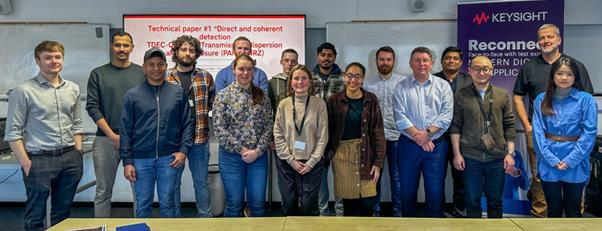
The University’s Digital Signal Processing Centre (DSP Centre) recently partnered with Keysight Technologies, a market-leading design, emulation, and test solutions company, to deliver a one-day training seminar on test and measurement techniques for communication systems.
The University’s Digital Signal Processing Centre (DSP Centre) recently partnered with Keysight Technologies, a market-leading design, emulation, and test solutions company, to deliver a oneday training seminar on test and measurement techniques for communication systems.
Electronic engineering students, researchers, and local telecommunications companies received technical lectures from Keysight experts, on topics ranging from instrument care and maintenance, to reducing test risk and improving measurement accuracy.
During the day, students got to hear about the career and placement opportunities that Keysight has to offer, and to chat about their studies with the DSP Centre’s current Master’s, PhD students and post-Doc Researchers. The day also included a tour of the DSP Centre’s research and innovation labs, which includes many pieces of Keysight’s state-of-the-art test equipment, and live demonstrations of the DSP Centre’s digital communications techniques. The Training Seminar forms one aspect of the ‘Social Value’ donation from Keysight, as part of its tender to supply the DSP Centre’s North Wales Growth Deal project equipment. The training seminar will be delivered annually for five years and aims to boost local skills and employment, and ultimately contribute to the economic and social wellbeing of the community.
“The Seminar was a great opportunity for students to strengthen their knowledge in test and measurement science, and to connect with peers, staff members, and industry professionals. We hope the training will support their studies and strengthen their enthusiasm to pursue a career in communications technologies.
It was a pleasure to collaborate with Keysight to organise and deliver this event, and to showcase the ground-breaking research in DSP-based communications that’s taking place here at Bangor University, supported by Keysight’s specialist equipment. We’re looking forward to continuing this partnership with Keysight to deliver another successful event next year.” Dr Roger Giddings, Senior Lecturer in Electronic Engineering and Deputy Operations Director of the DSP Centre
Further information and photos of the event are available on the DSP Centre’s Twitter and LinkedIn pages.
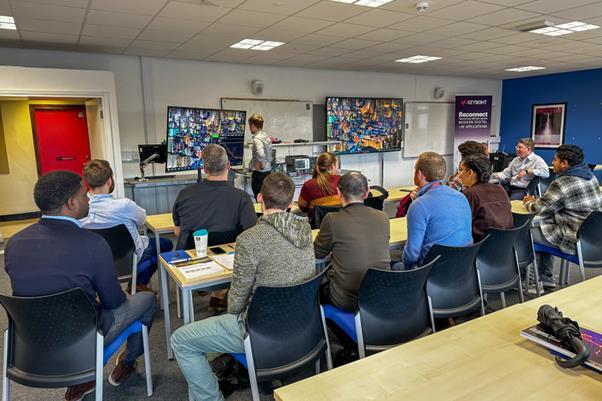

An Emeritus Professor at the School of Computer Science and Electronic Engineering has been awarded a prestigious national award at the National Eisteddfod of Wales.
The National Eisteddfod's Science and Technology Medal was presented this year to Professor Alan Shore for his lifelong contribution to digital electronics and the farreaching changes in the world of computing and communications.
He was honoured in a special ceremony on the Pavilion stage at the Llyn and Eifionydd Eisteddfod Maes on Friday, August 11.
His nomination said: "Alan is a first class scientist who has published and presented work on Photonics/Optoelectronics all over the world. But in addition to this he has worked tirelessly to present and developing Engineering in Wales and through the Welsh language.
"This is an area that has not traditionally been prominent in the Welsh language, and the first step was to foster and encourage a society of scientists in Wales in order to lay a foundation to develop the alphabet for the Welsh language."
Alan Shore is a native of New Tredegar and graduated in Mathematics from Jesus College, Oxford and later with a Doctorate at the University of Wales, Cardiff in the field of Photonics.
The early 1970s was a significant and exciting time in communication as he undertook his research in Cardiff. This period was also significant as he started to learn Welsh.

In 1995 Alan Shore was appointed Professor of Electronic Engineering at Bangor University, where he developed his work on Photonics and Optoelectronics.
Prior to this, he was a lecturer in Electronics Engineering at the University of Liverpool and later at Bath University. He spent research periods in laboratories around the world.
While working in England he kept in touch with scientists in Wales and contributed to the National Scientific Association conference.
He has endeavoured to weave the Welsh language within his educational work including coining Welsh acronyms for an international conference and an educational initiative in photonics for school students.
As Secretary of the Learned Society of Wales he has led the development of its language policy and organized the Association's Eisteddfod Lecture.
He is active with the Coleg Cymraeg Cenedlaethol and has been a member of the College's Research and Publishing Group since 2015. and as a member of the Mathematics, Physics, Engineering and Computing Panel, ensuring support and development for the use of Welsh in science and opportunities to study and publish through Welsh.
Alan Shore was chairman of the Science and Technology Committee of the Anglesey National Eisteddfod in 2017.

Researchers from Bangor University’s Digital Signal Processing Centre (DSP) have made a breakthrough in the development of a novel Point-to-Multipoint (P2MP) Optical Transceiver.
Optical Transceivers are widely used in data communication systems to transmit and receive signals over a network. The novel P2MP flexible transceiver overcomes the limitations of previous technologies in terms of just operating at pre-defined speeds over point-to-point transmission systems only.
As a direct result of the disadvantages associated with traditional optical transceivers, a current network node accommodating P2MP 5G access networks must use multiple traditional point-to-point (P2P) optical transceivers in parallel, each supporting a dedicated transmission link. Such network implementation and operation approaches are spectrally inefficient, energy-hungry, expensive and non-scalable in terms of meeting the stringent requirements of future access networks, including 5G-Advance and beyond.
To address these challenges, Bangor University researchers leading the way in DSP technology have turned their attention to point-to-multipoint (P2MP) transceivers, which have shown promise in offering scalable, flexible, and cost-effective solutions capable of supporting multiple low-speed optical transceivers to communicate with a single high-speed optical transceiver for cost-sensitive application scenarios. The transceivers can automatically and dynamically “grow” or “shrink”, depending on the network traffic status. These findings were recently presented in the Journal of Lightwave Technology, which is published by the Institute of Electrical and Electronics Engineers.
Dr Wei Jin, one of the co-authors of the paper from Bangor University’s School of Computer Science and Electronic Engineering said, “The breakthrough in P2MP transceiver technology presented in our research paper holds tremendous potential for revolutionizing existing optical access networks by transforming their virtual network topologies from P2P to P2MP in a scalable, flexible, low latency, and cost-effective manner.”
“Compared to traditional transceivers the reduction in transmitter digital signal processing complexity, improved spectral efficiency, and enhanced network security also make this solution highly promising for the future of optical access networks. As we continue to refine and optimize this technology, we can look forward to a new era of efficient and adaptable optical access networks that meet the growing demands of our interconnected world.”
The rapid growth of data traffic driven by the advent of 5G-Advance and beyond networks has created a pressing need for innovative solutions that can transform optical access networks. These non-incremental solutions must meet the increasing demands for connectivity density, bandwidth, cost-effectiveness, latency (the delay in receiving signals), reliability and security, while reducing capital and operational expenses.
“I am proud that the team at Bangor University’s Digital Signal Processing Centre, together with our colleagues in Shanghai, are making an important contribution to advancements in digital communications technology.
“The new transceivers will be field-trialed in FibreSpeed’s practical fibre networks along the A55 expressway. Together with the DSP Centre-developed other cutting-edge technologies including data-carrying optical signal-based sensing, physical-layer network security, and ultrafast optical switches (directly manipulating mobile traffic in the optical domain without performing O-E-O conversion), the new transceivers will be used to form a unique 5G/6G network, seamlessly converging fibre networks, radio networks and optical wireless networks, for example in our planned 5G Medical Innovation Lab. The network platform can simultaneously support multiple use cases that address strategic industrial challenges today and tomorrow.”
This work was part-funded by the European Regional Development Fund through Welsh Government, the North Wales Growth Deal through Ambition North Wales, Welsh Government and UK Government, the China Scholarship Council, the Science and Technology Commission of Shanghai Municipality Project Grant, the National Key Research and Development Programme of China and the Natural Science Foundation of China.
More about the DSP Centre for Excellence here
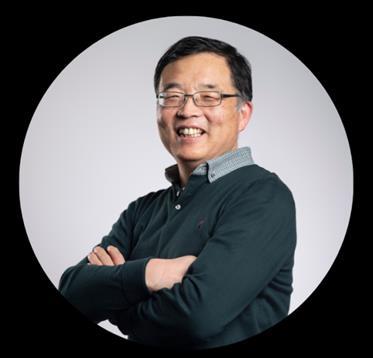
Above: Professor Jianming Tang, Operation Director at the DSP Centre at Bangor University and expert in optical communications research
If you’d like to share with your fellow alumni what you’ve been up to since graduation or your memories of your time in Bangor, please let us know and we will feature you in the next edition of the newsletter.
Send us your update along with a photo to:
alumni@bangor.ac.uk
Alwyn is recognized as one of the stalwarts of science in Wales especially through the medium of Welsh. Few have done more and worked harder and more practically, to bridge the unfortunate gulf that is seen too often between traditional Welsh culture and science and technology.
In recognition of his academic status, Alwyn was elected a Fellow of the Learned Society of Wales in 2011, a year after its establishment, and in the nineties he was Head of the School of Electronic Engineering at Bangor University.
But for many children in Wales his contributions to the Urdd and to the National Eisteddfod were the most obvious and important. With the enthusiastic support of his wife Ella, he led the branch of the Urdd in Porthaethwy for many years. He was also active at Wersyll Glan-llyn and as Chairman of the Science and Technology Committee of the National Eisteddfod and the National Scientific Society.
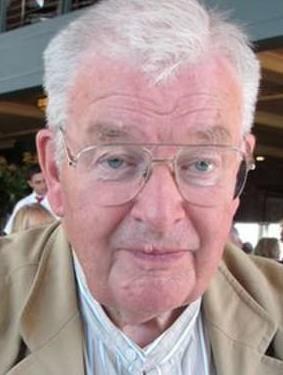
Yet Alwyn is not remembered as a committee-man. He was a practical person; a catalyst for the 'Wil i'w Wely' competition for young people nationally and a great help to the development of the scientific and technology offer in the National Eisteddfod and the Urdd. At one stage, we believe, Alwyn was responsible, personally and entirely voluntarily, for the sound from the stage at the National. He also organized the lighting in productions and many plays. He received the Science and Technology Medal at the Denbigh Eisteddfod in 2013 in recognition of all his contributions.
Practical engineering was Alwyn's passion and fittingly, he was accepted into the Gorsedd as “Alwyn Peirianydd” – “Alwyn Engineer”. He was a genius at making gadgets. A long time ago one of the authors bought a pH measuring device that was designed by Alwyn and used it in the lab for years.
Although he was born in Pwllheli, Alwyn was a Llanrwst boy and one of the bright products of the Grammar School. He then went to Bangor to study electronic engineering before the electronic revolution changed our lives. On to Manchester to work on data storage systems and also receive a master's degree in Mathematics. He spent five years at the Atomic Energy Research Establishment in Harwell working on the world's first transistorised sampling oscilloscope and other inventions. There very sadly Enid his first wife died young. He was drawn back to Bangor as a lecturer in his old department where he was an integral part of the setup for almost 40 years. As a senior lecturer in electronic engineering, Alwyn's influence on generations of engineering students was enormous. He continued his links with Harwell, and supervised a number of successful doctoral students, applying his deep understanding of signal processing technology and analogue electronics. His practical talents were legendary at school, for example his ability to change the electrical capacitance of an electronic circuit board by scraping away the copper with a drill bit between his finger and thumb thereby improving the performance of the circuit far beyond the expected. In addition to these engineering talents, Alwyn's wise advice at the school meant that Alwyn was an important part of the experiences and memories of staff and students over the decades. There will be a big void (Alwyn would prefer, with a nod to semiconductor science, that we said “hole”) left behind him in Dean Street.
We remember Alwyn as a gentle, friendly, fun, and reliable man. One full of fun and mischief but active and dedicated. He was a loyal member of several local organizations including Clwb yr Efail. Typical of him is that at the age of 92 he gave his latest paper to Clwb yr Efail on his family connection and the famous Closiaid tribe from Nant Peris a few weeks before his sudden death. He was not in good health for several years but he continued, with the help of Ella and his friends, to come to the Gwynedd Scientific Society and Clwb yr efail meetins and to attend other events around the Menai.
Ella and Alwyn had three children: Angharad, Aneurin and Rhiannon. His family, here in Wales and in America was extremely important to him but it is fair to note his special pleasure that one of his grandchildren is following in his footsteps studying physics and engineering at CERN and in Oxford.
He will be greatly missed at the school, in the area and nationally.
Professor Gareth Wyn Jones
Dr Iestyn Pierce


“Engineering gave me a great and interesting career and life”
“In reading the last couple of pages of the last School of Computer Science and Electronic Engineering Newsletter, there seems to be some magnetic pull for Bangor graduates to the snow and ice.
However, rather than taking a boat or driving to the Arctic Circle, I skied there. In 2019 I became the first, and so far only, Brit to ski the world’s longest cross country ski trek – 1800km in 33 days from the south coast of Finland to the Arctic Ocean in Norway.
I first learned to ski at Bangor where I was the secretary of the ski club back in my final year of a joint honours degree in Electronic Engineering and Physical Oceanography graduating in 1975. I have had a long career in electronics (mostly) but did work on research into wave and solar energy back in the 1980s. I ended up in semiconductors and then into high performance computing, and for the last 30+ years have been involved in and managing EC funded R&D projects in everything from high speed networking, smartcards, automotive, e-learning, cloud computing, medical electronics – just to prove you can teach an old dog new tricks. I put my engineering skills to the test along the way building my own house, and have had the fun of working in France, the US and Belgium along the way. When Prof Stephenson back in 1975 said that as engineers we could expect two major career changes along the way, he was definitely predicting my future.
I don’t know if anyone remembers that in the early 1970s the University’s old mainframe – an Elliot 803 - was available for students to experiment with, but you had to pass a competence test first. Little did I know then the connections that I would discover on this. I later worked at Inmos, where I discovered that Iann Barron, the founder of Inmos, had designed this computer, and the Algol 60 compiler (which took up 5.5k of the 8k of 22 bit memory) was written by Tony Hoare, who was one of the two architects of the occam language that was used to program Inmos’s transputer. In another twist of fate, ARM was spun out of Acorn in the first EC funded project I was managing, so I have had a ring side seat at a lot of developments in computing in my career – not yet finished as I am slowly winding down work, but only to have more active time (off to the World Pilot Gig Rowing championships next).
Engineering gave me a great and interesting career and life, and doing joint honours gave me a taste of being flexible and ending up as a “jack of all trades, master of none” which is ideal for project management where you need enough knowledge to understand what is being done but not too much that you interfere with telling people how to do their jobs and micro-managing.”